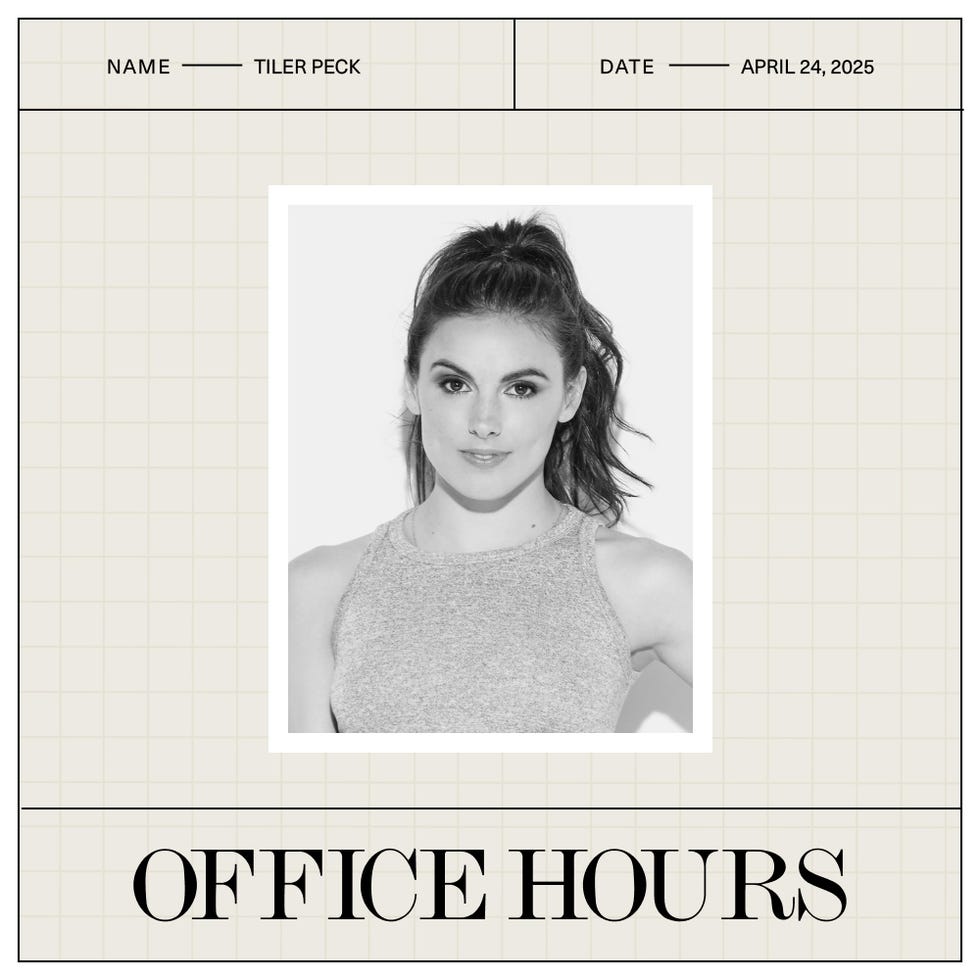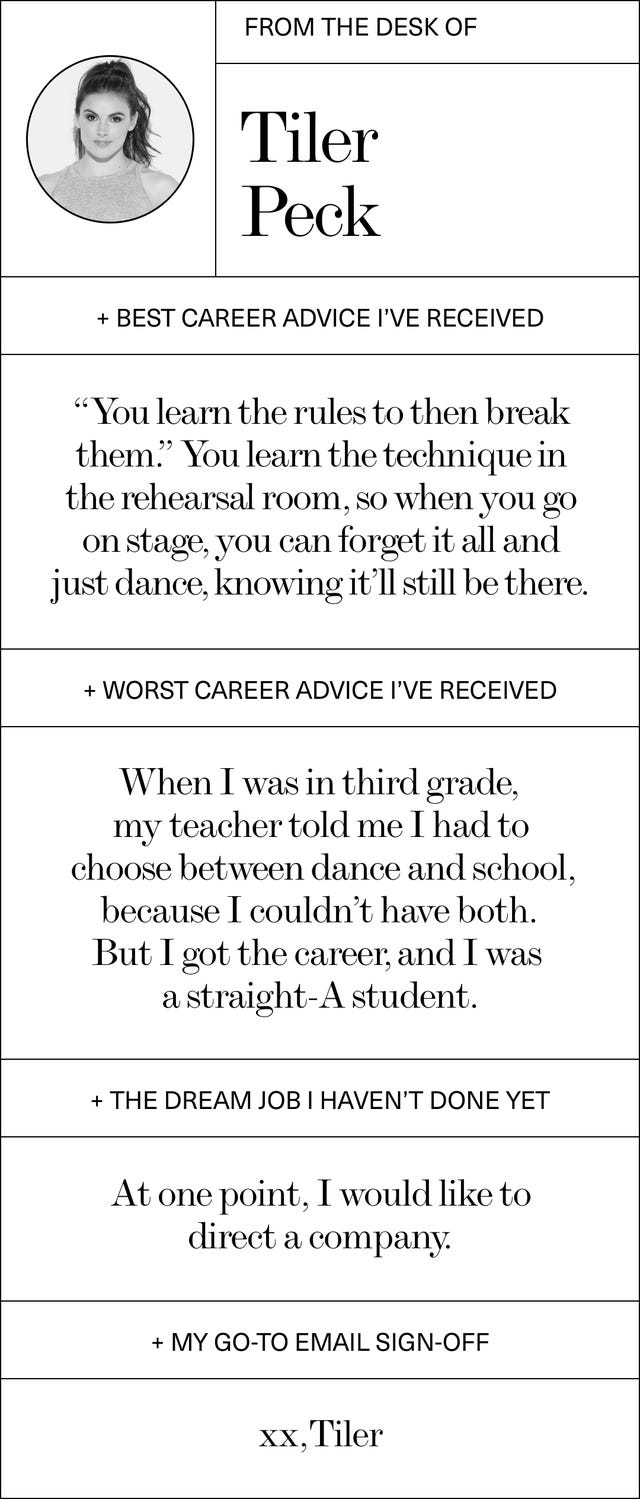Tiler Peck’s Ballerina Role in <i>Étoile</i> Was Written Just For Her


In ELLE’s series Office Hours, we ask people in powerful positions to take us through their first jobs, worst jobs, and everything in between. This month, we spoke with Tiler Peck, a principal dancer at the New York City Ballet, who’s been described as the kind of ballerina who can “stop time” on stage. She first moved to New York as a kid, performing on Broadway and training at the prestigious School of American Ballet, before joining the NYCB company as a teenager. Peck has since performed the kinds of traditional roles little girls dream of: Aurora in The Sleeping Beauty; Odette/Odile in Swan Lake; and the Sugar Plum Fairy in The Nutcracker. But offstage, her career is particularly modern. Peck has choreographed her own ballets, collaborated on a line of dancewear, and become a published author (her next book, XO Ballerina Big Sis, which offers advice for young dancers, is out in October). She also has a role in the new Amazon Prime series, Étoile, the latest from the creators behind Gilmore Girls and The Marvelous Mrs. Maisel. (Peck’s fiancé and NYCB dancing partner, Roman Mejia, also makes a cameo.) Below, she reveals how she ended up in spring’s most delightful TV show, the meal she eats before every performance, and more.
My first jobMy first job was dancing in a Skechers commercial. I was really, really young—6 years old—and I’m not even sure how I got involved. My sister used to do a few TV stints, so I think my mom was just like, oh, we’ll just put [Tiler] in that. I remember meeting some really amazing older dancers [on set], and they danced at this studio in Downey, California. They said to my mom, “Your daughter is really talented. I think you should bring her to our studio.” And that ended up being my studio I went to for years—it really trained me. So, I’m very glad I did that job.
My worst job
There are definitely worse ballets to be a part of; we have new people come and choreograph all the time, and it’s an honor to be included in the new ballets, but sometimes they’re really not good, and you just wish you weren’t called. But you have to do the dance, so I always try to be committed, even if I think it’s bad. I don’t want to name the ballets, but I’ve definitely have been a part of some doozies.

When I realized I wanted to be a ballerina
My mom was a dancer, and she owned a dance studio, so she was my first teacher. She said, as soon as I could walk, I was in the back of the room, trying to do what she was teaching the older kids. I honestly don’t remember a time without dance. Even if we were at home in the kitchen, I was turning because the floor was really good, and I could do lots of turns. Or I played soccer, but I was doing leaps down the field. I just was always dancing. But ballet was my least favorite. I only did it because my mom was like, “You have to have good technique, and that comes from ballet.” Thank God she made me do that. It wasn’t until I saw the New York City Ballet’s The Nutcracker when I was 11, and I was like, “Daddy, I’m going to dance on that stage someday.”
How I became a professional dancer as a teenagerI’m from California, but [when I was around 12 years old] I was living in New York doing a Broadway show. I would go to the New York City Ballet’s School of American Ballet during the day and then do the show at night. Then, the show closed. I really missed my parents, because they had to stay at home and work, and I’d been living with my grandmother. So I went home, but I told SAB I’d keep coming back for their summer courses. I did that for two years, and I finally stayed [full-time] when I was 14. I got in the company after that year, so it was quick. I lived in the dormitory, and it was like going to college, but much earlier. Some of my closest friends are from the dorms, because you spend so much time together at this age when you’re really developing. [The experience] made me really self-sufficient at a young age. I had to learn how to do things on my own and be responsible much earlier.
My “I made it” moment
Probably getting promoted to principal [dancer]. I was in a rehearsal, and I remember asking my boss for a release because my sister was getting married at the time, and I needed to be her maid of honor. And he was like, “But that’s when my new ballet goes. It’s all principal dancers.” And I was like, “But I’m a soloist.” He kind of brushed it off and said, “We’ll make it work.” Then we were in rehearsal for that ballet, and he came up to me specifically and said, “Can you do a double pirouette here instead of a single?” And I was like, “Yes...” He was like, “Of course you can, because you’re a principal dancer.” Then he looked at the other people—we were all soloists—and he was like, “You’re all principal dancers.” Then he just kept going, but we were all looking around like, Wait, is this a joke? Two minutes later, he said, “Oh, do you guys want to celebrate?”
I’ve been a principal now for 15 years, and still sometimes I get off stage and I’m like, “How did this happen?” It’s a dream come true.
We have class every day at 10:30 A.M. It’s not mandatory, but to me, it is. If I want to keep getting better and working on my technique, it’s how you start your day. So 10:30 A.M. to 12 P.M. is class and then they can rehearse us from 12-6 P.M. The most you’ll have is 12-3 P.M., an hour off, and 4-6 P.M. rehearsal. Then, you could have a show at night. That’s every day but Monday, which is our day off.
We get our schedule two days in advance, and then once the schedule comes out, the physical therapy hours come out. So you schedule your PT or your gyrotonic when you are not in rehearsal. Same with costume fittings—everything is based on our hours, if needed, for rehearsal. At night, you’re spending all your time recovering. Either you’re icing or you’re heating your back or you’re taking Epsom salt baths. It doesn’t end when the show or the rehearsal day is over.

What it was like working on Étoile
The choreographer [on the show] was my jazz teacher when I was eight years old, and when she started this project, she told me, “Wouldn’t it be fun if our worlds collided?” They had me read to see if I could act, and then, that was it. It was like, “Amy [Sherman-Palladino] is writing a part for you.”
[The show’s creators] Amy and Dan [Palladino] directed different episodes, but they were there every single day. It was just wonderful to be with directors who really respected the art form. I feel like it’s easy to make a show that the masses will enjoy watching, but it’s even harder to make a show that the dance community will enjoy. The two of them took the time to do this in an authentic way. I remember Dan was writing an episode when I was shooting, and he was like, “Tiler, come here. Who would be the one ballerina that you guys would all look up to?” And I said, “Oh, I guess Maya Plisetskaya.” He was like, “Oh my God, and that’s an amazing sound to say.” It was fun to be a little part of that. I just had a ball. And Amy really loves ballet. I remember we were shooting a dance scene, and she was like, “Somebody’s arm is not right.” And I was like, Oh my God. She really does know.
The best part about marrying my dancing partner
We started as partners at the ballet long before it was anything romantic, so we have a beautiful partnership in studio and on stage. The fact that it’s more than that now just makes it so easy. I feel pretty lucky. Also, it’s hard for any normal person to understand our schedules; it’s really nice that we get what we’re going through.
We’re pretty much together 24/7, so it’s kind of amazing we still don’t get sick of each other. We won’t see each other for two hours, and we’re like, “Oh my God, I missed you.” I feel like if there is ever an argument, it’s about a dance step or something, as opposed to something really serious. I remember there was something that kept going wrong [in rehearsal], and I looked at him, and I was like, “You need to focus.” And he was like, “You need to focus.” And I just started laughing. I think that was the worst it’s ever gotten.

Peck and her fiancé, Roman Mejia
How I’ve learned to deal with injuries
Injuries are the worst part [of the job], because they affect you not only physically, but mentally. You’re not able to do the thing you love. That’s taken away from you, and you have to sit and be okay with the uncertainty of what’s going to happen. You have to just give the body the time to heal, which is the hardest part, because as dancers, we’re used to fixing it. Like, “Okay, tell me what’s wrong, and I’ll fix it.” But with an injury, it’s not on your own timeline. It forces you to focus on yourself as a human being, without being a dancer. So you grow as a person, which then obviously affects the way you dance. I feel like those life realizations or epiphanies, they make you more of an artist when you come back.
This interview has been edited and condensed for clarity.
elle




